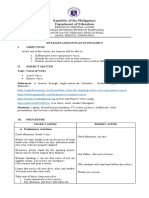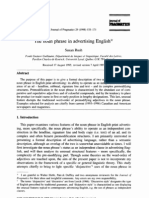Stompi Notes
Stompi Notes
Uploaded by
ganiasma758Copyright:
Available Formats
Stompi Notes
Stompi Notes
Uploaded by
ganiasma758Original Description:
Original Title
Copyright
Available Formats
Share this document
Did you find this document useful?
Is this content inappropriate?
Copyright:
Available Formats
Stompi Notes
Stompi Notes
Uploaded by
ganiasma758Copyright:
Available Formats
S V1 T O M P V2- woordorde
Steps to follow
Step 1: Underline the verbs in the sentence.
Step 2: That which stands infront of
the VERB 1 is the SUBJECT. That which stands
after the second verb is the INFINITIVE.
Step 3: Now begin at the beginning of the
sentence, which part of STOMPI is present in
the sentence. REMEMBER: A sentence does
not have to have all the STOMPI parts.
Just remember WHATEVER YOU START WITH THE VERB
ONE FOLLOWS!!!!
If the sentence start with:
Subject = S v1TOMPv21
Verb 1 = v1 STOMPv2I?
Time = T v1 SOMPv2I
Object = O v1 (T+M) deur SPv21 (active and passive)
Manner = M v1 STOPv2I
Place P v1 STOMv2I
Verb 2-YOU CAN NEVER START A SENTENCE WITH V2.
Infinitive = I v1 STOMPv2
What does SV1TOMPV2 stand for .
Die seun het gister sy rugbybal hard oor die pale geskop om te oefen.
ubject
Usually stands in the beginning of the sentence.
The subject is that what the sentence is all about.
Die subject answers the WHO/WHAT question.
DIE SEUN het gister sy rugbybal hard oor die pale geskop om te
oefen.
erb 1
It's the first verb in the sentence.
The first verb is divided into two groups:
Present tense: Main verb of the sentence.
There is no second verb
Past and future tense: the first verb is the helping verb in the
two different tenses.
Past: HET, WOU, SOU, KON, MOES.
Future: SAL, WIL, KAN, MOET
Die seun het gister sy rugbybal hard oor die pale geskop
om te oefen.
ime
Any indication of time.
The time answers the WHEN question.
Die seun het gister sy rugbybal hard oor die pale geskop
om te oefen.
bject
The object is that which it being done.
What VERB's the SUBJECT?
The answer to this question is the object.
The subject and the object looks the same, this is only because they
swop positions in the Active and Passive voice.
Die seun het gister sy rugbybal hard oor die pale
geskop om te oefen.
anner
The MANNER answers the HOW question.
How is it being done.
The MANNER is an adjective (byvoeglike naamwoord) or adverb (bywoord).
The describing word can be put into degrees of comparison.
Die seun het gister sy rugbybal hard oor die pale geskop
om te oefen.
lace
The Place answers the WHERE question.
The PLACE always has a preposition (voorsetsel), it is the preposition
that gives away the place
Voorsetsels: IN, AAN, AGTER, BY, BO, LANGS, MET, NA, ONDER, OM, OOR, OP,
TEEN, UIT,VOOR, ens.
Die seun het gistersy rugbybal hard oor die pale geskop
om te oefen.
erb 2
The second verb of the sentence.
The present tense sentence does not have a second verb.
The second verb is the main verb in the past and future tense sentences.
The past tense verb usually has a "ge" in front of the word.
Die seun het gistersy rugbybal hard oor die pale geskop om te
oefen.
nfinitive
The infinitive answers the WHY question.
The infinitive is actually the easiest to identify.
Everything from OM... TE... to the end of the sentence is the infinitive.
The infinitive gives you the reason for what is said in the beginning of the
sentence.
Die seun het gistersy rugbybal hard oor die pale geskop
om te oefen.
You might also like
- Detailed Lesson Plan Past Perfect TenseDocument8 pagesDetailed Lesson Plan Past Perfect TensePre Decampong89% (19)
- Afrikaans Taal Study NotesDocument11 pagesAfrikaans Taal Study NotesAli100% (1)
- Detailed Lesson Plan Past Perfect TenseDocument12 pagesDetailed Lesson Plan Past Perfect TenseJinkikay Parallag Gampong100% (1)
- Lesson Plan (6.active and Passive)Document7 pagesLesson Plan (6.active and Passive)Mary Grace Fenol Dilag90% (10)
- SV 1 TOMPv 2 IDocument37 pagesSV 1 TOMPv 2 IDW TaylorNo ratings yet
- Stompi Back To Basics - Engelse WeergaweDocument37 pagesStompi Back To Basics - Engelse WeergaweGloria CharlesNo ratings yet
- Apuntes Gramática Inglés 1 EsoDocument17 pagesApuntes Gramática Inglés 1 EsoSara Iglesias100% (1)
- ELC231 WEEK 1 Writing SentencesDocument17 pagesELC231 WEEK 1 Writing SentencesMUHAMMAD SYAHMI ZAKWAN MOHD SHAHROLNo ratings yet
- Topic: Subject-Verb Agreement Course: English B: Directed Learning ActivityDocument8 pagesTopic: Subject-Verb Agreement Course: English B: Directed Learning ActivityLove ApallaNo ratings yet
- Q1 Word Order and InterjectionsDocument26 pagesQ1 Word Order and InterjectionsIvy AnteNo ratings yet
- Detailed Lesson Plan in English 9Document7 pagesDetailed Lesson Plan in English 9Sophia Vanette SapnuNo ratings yet
- Presentación 2Document2 pagesPresentación 2ljavierNo ratings yet
- Módulo 4: IntroducciónDocument32 pagesMódulo 4: IntroducciónpaulinaNo ratings yet
- English GramerDocument26 pagesEnglish Gramerbrahma_sahdaNo ratings yet
- Presentation 2Document23 pagesPresentation 2Renaldy MamarasiNo ratings yet
- Reported Speech: Teacher: Virginia SanchezDocument22 pagesReported Speech: Teacher: Virginia SanchezCarlos Uriel Martinez TinocoNo ratings yet
- Continuous tense._20240913_105134_0000Document21 pagesContinuous tense._20240913_105134_0000gerald.silva2007No ratings yet
- 1o Ano Favelas The Present Continuous TenseDocument6 pages1o Ano Favelas The Present Continuous Tenseretavares34100% (1)
- SY 23-24 CHINESE Lesson 1 Chinese AlphabetDocument3 pagesSY 23-24 CHINESE Lesson 1 Chinese AlphabetJenard JimpitNo ratings yet
- Les VerbesDocument20 pagesLes VerbespppNo ratings yet
- Adjectivesnounsverbs 090616193127 Phpapp02Document14 pagesAdjectivesnounsverbs 090616193127 Phpapp02Jihan nafisa20No ratings yet
- 06-Lesson 5Document3 pages06-Lesson 5Carlos MendesNo ratings yet
- ENGLISH 4 Perfect TensesDocument25 pagesENGLISH 4 Perfect Tensesmanerateles9No ratings yet
- 1st PERIOD (GUIDE #1)Document11 pages1st PERIOD (GUIDE #1)Yeraldí SánchezNo ratings yet
- Did - Pergunta e NegaçãoDocument13 pagesDid - Pergunta e NegaçãoAriane Stela ScatolinNo ratings yet
- Grade 11 - Afrikaans - Sv1TOMPv2IDocument3 pagesGrade 11 - Afrikaans - Sv1TOMPv2IrosettakerlaNo ratings yet
- 3 INGLES Taller Presente Simple y ContinuoDocument6 pages3 INGLES Taller Presente Simple y ContinuoMoisésNo ratings yet
- Past Progressive InfographicDocument3 pagesPast Progressive InfographicÓscar Alejandro Bernal ObandoNo ratings yet
- Active and PassiveDocument6 pagesActive and PassiveFerliza Cudiamat PacionNo ratings yet
- LING 103 2016 Syntax 4Document24 pagesLING 103 2016 Syntax 4Bao NgohoaNo ratings yet
- Using The Progressive Verb Tense Education Presentation in Yellow Purple Simple Lined StyleDocument14 pagesUsing The Progressive Verb Tense Education Presentation in Yellow Purple Simple Lined StyleMinh Hằng PhạmNo ratings yet
- Lesson Plan For GrammarDocument6 pagesLesson Plan For Grammarhounggiang0906No ratings yet
- Simple Past VS PAST CONTINUOS EXPLANATIONDocument6 pagesSimple Past VS PAST CONTINUOS EXPLANATIONSharaNo ratings yet
- 10° Inglés 10 - Guía 3Document10 pages10° Inglés 10 - Guía 3Juanito GamerNo ratings yet
- Lang+Dev Grammar RLV Tenses 05 English V CBDocument12 pagesLang+Dev Grammar RLV Tenses 05 English V CBkavitabavishaNo ratings yet
- Subject PredicateDocument69 pagesSubject PredicateyuldaNo ratings yet
- Gr10 Active Passive Voice TheoryDocument9 pagesGr10 Active Passive Voice TheoryGilliane Grace GarciaNo ratings yet
- Simple Present Tense Is When We Add The Letter - S - ES - or IES - To The VerbsDocument3 pagesSimple Present Tense Is When We Add The Letter - S - ES - or IES - To The Verbsamores.jireh16No ratings yet
- GRAMMARDocument6 pagesGRAMMARCierly Mae TantanNo ratings yet
- TaalboekDocument43 pagesTaalboekRorisang MohaleNo ratings yet
- Detailed Lesson Plan in English 9Document8 pagesDetailed Lesson Plan in English 9John Kenneth SantosNo ratings yet
- Lesson PlanDocument14 pagesLesson Planmaricopsales24No ratings yet
- English 2 - Resumen 1ra Etapa PDFDocument39 pagesEnglish 2 - Resumen 1ra Etapa PDFWilson ReasNo ratings yet
- Review Adj - Noun - Verb - AdvDocument14 pagesReview Adj - Noun - Verb - AdvNguyen ThyNo ratings yet
- Lesson Plan 6 Active and PassiveDocument6 pagesLesson Plan 6 Active and PassiveanneNo ratings yet
- Basico 4 Students ManualDocument23 pagesBasico 4 Students Manualedustage.95No ratings yet
- Syntax PDFDocument9 pagesSyntax PDFAmin MofrehNo ratings yet
- Ketting Formulier Past Simple TenseDocument27 pagesKetting Formulier Past Simple TenseYohanan Moraes IsbellNo ratings yet
- Evidencia de Cuaderno INGLES 1 PEDocument8 pagesEvidencia de Cuaderno INGLES 1 PEJuan Pablo Martínez RestrepoNo ratings yet
- B1 Inversion-Notes PPT - UNCDocument7 pagesB1 Inversion-Notes PPT - UNCcamiarias931No ratings yet
- Verb PhrasesDocument29 pagesVerb PhrasesLe Tuyet NhiNo ratings yet
- InglesDocument20 pagesInglesJesús RamsésNo ratings yet
- Revised Deductive Lesson Plan Group 3Document5 pagesRevised Deductive Lesson Plan Group 3Queen RosieNo ratings yet
- Ge PresentationDocument17 pagesGe Presentationsaniya072202No ratings yet
- Ingles 1° A-B-C 1° Act. Duberlys GomezDocument7 pagesIngles 1° A-B-C 1° Act. Duberlys GomezDVentas DuacaNo ratings yet
- Tuttle Pocket Korean Dictionary: Korean-English English-KoreanFrom EverandTuttle Pocket Korean Dictionary: Korean-English English-KoreanRating: 3 out of 5 stars3/5 (1)
- Verb PresentationDocument21 pagesVerb PresentationM Aziz M SharifNo ratings yet
- OET Writing Grammar PDFDocument106 pagesOET Writing Grammar PDFRaga SownthariyaNo ratings yet
- First Year Latin 00 Coll RichDocument340 pagesFirst Year Latin 00 Coll RichfsolomonNo ratings yet
- TuesdayDocument13 pagesTuesdaytlili.slimaniNo ratings yet
- The Noun Phrase in Ads EnglishDocument17 pagesThe Noun Phrase in Ads EnglishMemay ManiemanyNo ratings yet
- About The Module: Ready?Document9 pagesAbout The Module: Ready?Cheyenne LabiranNo ratings yet
- Ingles-Teoría 6toDocument3 pagesIngles-Teoría 6toPatricia TudorNo ratings yet
- Subject-Verb AgreementDocument35 pagesSubject-Verb AgreementNandy DacoycoyNo ratings yet
- TEST Grammar Exam-1Document47 pagesTEST Grammar Exam-1Rizat KozykenovaNo ratings yet
- TERM-2 Reported SpeechDocument3 pagesTERM-2 Reported SpeechMujtaba Ahmed SyedNo ratings yet
- English Reviewer Nouns&PronounsDocument3 pagesEnglish Reviewer Nouns&PronounsrodledresNo ratings yet
- Conjunction TheoryDocument5 pagesConjunction Theorybluenight99100% (1)
- 10 1 1 103 4227 PDFDocument375 pages10 1 1 103 4227 PDFDEEPAK KUMARNo ratings yet
- Cleft SentencesDocument6 pagesCleft SentencesMaría Daniela Broccardo100% (1)
- Subject-Verb AgreementDocument19 pagesSubject-Verb AgreementChristian Rome DizonNo ratings yet
- Unit 1: Grammar 1. Personal PronounsDocument17 pagesUnit 1: Grammar 1. Personal PronounsannisaNo ratings yet
- Clause Type and Illocutionary Force PDFDocument96 pagesClause Type and Illocutionary Force PDFRenata RochaNo ratings yet
- ELP ModuleDocument82 pagesELP ModuleYsabelle TomeNo ratings yet
- Kognitív 2.zh ÖsszesDocument229 pagesKognitív 2.zh ÖsszesBlankaHajzerNo ratings yet
- English Lec For LETDocument11 pagesEnglish Lec For LETJessamyne Jade MelitonNo ratings yet
- MR Sentence Correction Guide VietAcceptedDocument70 pagesMR Sentence Correction Guide VietAcceptedThorNo ratings yet
- Simple Present TensDocument6 pagesSimple Present TensZikriNo ratings yet
- Bu dc33 Pue Full PDFDocument510 pagesBu dc33 Pue Full PDFRostislav GadeiNo ratings yet
- EnglishDocument5 pagesEnglishSiti HajarNo ratings yet
- Lesson Plan - Tamil - Grade - 3Document3 pagesLesson Plan - Tamil - Grade - 3acrs3111No ratings yet
- Cohesion in Cantonese-Speaking Children's Picture-Elicited NarrativesDocument42 pagesCohesion in Cantonese-Speaking Children's Picture-Elicited NarrativesSajadAbdaliNo ratings yet
- SDCSD: by Academic DoctorDocument13 pagesSDCSD: by Academic DoctorZara AhmedNo ratings yet
- Theory Infinitive and Ing FormsDocument2 pagesTheory Infinitive and Ing Formslilicamp100% (1)
- Examiners' Report: Principal Examiner FeedbackDocument25 pagesExaminers' Report: Principal Examiner FeedbackRafaNo ratings yet
- VerbsDocument8 pagesVerbsShemiah GonzalesNo ratings yet

























































































